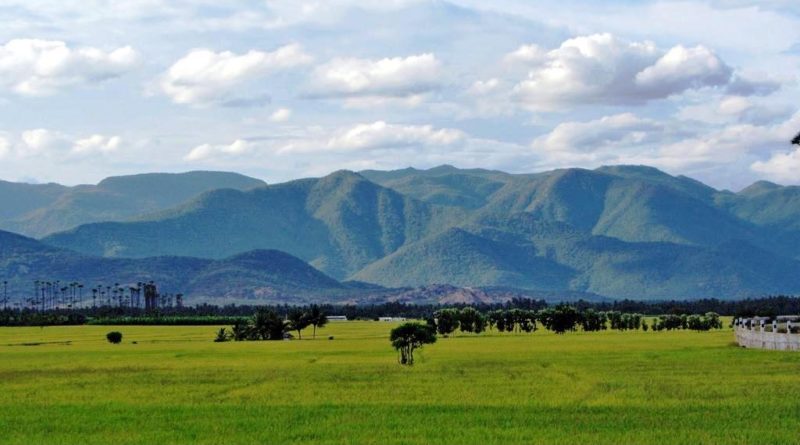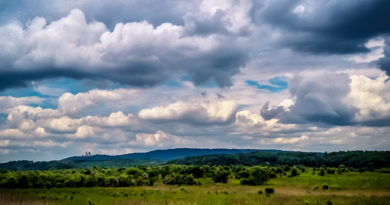388 Western Ghats Villages In Maharashtra May Be Denied Eco Protections
The Maharashtra government wants to deny protections from mining and industrial activity to 388 villages in the Western Ghats. The extent of ‘ecologically sensitive areas’ (ESA) would be cut by 11% from that proposed by the central government earlier–for what the government terms “essential development requirements of the state” according to the Maharashtra government proposal to the union environment ministry, accessed by IndiaSpend under the Right to Information Act.
The area of the Western Ghats in Maharashtra to be declared protected will reduce from 17,340 sq km to 15,359.40 sq km if the central environment ministry approves the proposal. Among the villages to be excluded are some where companies have been pulled up for pollution and for operating without environmental permissions. They are also home to the Indian gaur and form a crucial corridor used by tigers and elephants.
The Western Ghats, rich in biodiversity, are the source of several perennial rivers and crucial for the southwest monsoon in the entire Indian peninsula, home to nearly 245 million people. It is also home to species of flora and fauna that are only found there.
The decision to tag areas as ESA is crucial as tagging, once approved by the central environment ministry, debars mining, quarrying, sand mining and polluting industries.
Maharashtra’s proposal was part of a response in ongoing consultations between the Centre and the six states on the October 2018 draft notification demarcating ESA in the Western Ghats.
The environment ministry has published four draft notifications on ESA–in 2014, 2015, 2017 and 2018. With each republication, states have demanded relaxation or changes in ESA. In the meantime, the Ghats have been under pressure due to infrastructure development in the area.
Studies show that the green cover in the Ghats is shrinking. Dense forest areas in the northern, central and southern Western Ghats have decreased by 2.84%, 4.38% and 5.77%, respectively, between 2006 and 2016, found a study by the Indian Institute of Science (IISc), Bengaluru, as IndiaSpend reported in June 2016.
Ecologically sensitive villages
About 60% of the Western Ghats region is under ‘cultural landscape’, dominated by humans, agriculture and plantations other than forests, while 40% of the land area is ‘natural landscape’, the Kasturirangan report said. Of the natural landscape, about 37% (~60,000 sq km) is biologically rich.
The villages to be excluded under the Maharashtra government proposal meet the Kasturirangan report’s ‘natural landscapes’ classification and most of them were included in the ESA list in the Kasturirangan report.
In Konkan, the state government has completely omitted the Dodamarg taluka of Sindhudurg district from the ambit of the ESA, even as the Bombay High Court ordered in 2013 that the state government should declare the Sawantwadi-Dodamarg stretch as an ESA to conserve its wildlife corridors and water resources.
All of Kolhapur’s excluded villages have a natural landscape of 40% or above, with the maximum being 99%, as per data from Maharashtra Remote Sensing Application Centre.
An October 4, 2018 draft notification on the Western Ghats issued by the Ministry of Environment, Forest and Climate Change (MoEF&CC) had proposed to declare 2,133 villages in Maharashtra as ESA–landscapes that have high biological richness, low fragmentation and low population density, and those that may comprise of protected areas, world heritage sites, and tiger and elephant corridors. However, the Maharashtra state government has proposed to classify only 2,092 villages as eco-sensitive, in the report accessed by IndiaSpend under the Right to Information Act.
The 388 excluded villages are not within the ESA boundary and some were omitted as they were mining villages or because designated industrial zones already existed in these villages, the state government has said in its proposal. Maharashtra has also proposed to add 347 villages to the ESA list that were previously not classified as ESA.
Once an area is marked as ESA, all existing mines need to be phased out within five years from the date of the final notification or on the expiry of the existing mining lease, whichever is earlier. All new ‘red’ category or highly polluting industries, and the expansion of any existing industries will be prohibited in areas marked ESA.
This Maharashtra government proposal is in line with previous decisions by various state and central governments approving projects in ecologically sensitive areas. Over 500 projects were cleared in India’s protected and eco-sensitive areas by the National Board of Wildlife over the four years of the Narendra Modi-led National Democratic Alliance government between June 2014 and May 2018, as IndiaSpend reported in September 2018. In comparison, the preceding United Progressive Alliance (UPA) government had cleared 260 projects between 2009 and 2013.
Similarly, India’s environment ministry exempted 13 pending railway projects, worth Rs 19,400 crore ($2.8 billion) and spread over 800 hectares of land, from the process of seeking forest permits, as IndiaSpend reported in July 2019.
Delayed eco-sensitive area demarcation
On October 4, 2018, in a draft notification, the MoEF&CC had declared an area of 56,825 sq km of the Ghats as eco-sensitive, based on a 2013 report of the K.Kasturirangan-led high-level working group on conservation of the Western Ghats.
However, six years since the union government under the UPA accepted the report, Gujarat, Maharashtra, Goa, Karnataka, Tamil Nadu and Kerala–the states through which the Western Ghats run–have been unable to arrive at a consensus on the final ESA notification for the Ghats.
Some of the villages excluded from the state’s ESA in Kolhapur and Sindhudurg districts are home to the Indian gaur, and part of wildlife corridors used by tigers and elephants moving between Karnataka, Goa and Maharashtra.
The list also includes villages from Ratnagiri district, such as Kumbhavade and Vilye, that are situated close to the Nanar oil-refinery and petrochemical complex, which was stalled following protests by locals over its environmental impact on horticulture in the area. The villages that would have been impacted grow the world-famous alphonso mango, as well as cashew, areca nut and betel leaf.
Nivale in Shahuwadi taluka and Savarde in Radhanagari taluka–not classified as ESA in the proposal–were notified as part of the Chandoli National Park and Radhanagari wildlife sanctuary, respectively, as per the Maharashtra government notifications for the park and sanctuary.
A text message seeking comment on Maharashtra’s proposal was sent to Sunita Narain, one of the members of the high-level working group that prepared the K Kasturirangan report on the ESA in the Western Ghats, but we did not receive a response.
“The rejection of the Madhav Gadgil committee report and stripping of ESA protection will not bode well, especially in the wake of recent floods that happened in the district,” said Uday Gaikwad, a Kolhapur-based environmental activist, and convener of Vidnyan Prabhodini, a nonprofit promoting environmental awareness. The exclusion of villages in Kolhapur from the ESA poses a threat to the district’s wildlife and water security, he added.
The Madhav Gadgil committee report was prepared by the Western Ghats Ecology Expert Panel and submitted to the Union environment ministry on August 31, 2011. It recommended demarcation of Ecologically Sensitive Zones as ESZ 1, 2 and 3 across 142 talukas of the Western Ghats based on their ecological fragility. It also called for a complete ban on mining, dams and construction in ESZ1 areas.
Mining villages excluded
Villages were not considered ESA because these were mining villages, fell outside the larger ESA area in the central government draft notification, fell in the Maharashtra Industrial Development Corporation (MIDC) zones or fell in ‘special zones’, as per Maharashtra’s latest proposal to the union environment ministry in December 2018, which we accessed through RTI. It did not define special zones.
Of 388 villages, 55 across Raigad, Pune and Ratnagiri district fell in the MIDC industrial zone, 19 were mining villages and the rest were mostly outlying villages.
“Mining has become a huge source of illicit money-making in villages situated in Western Ghats and even locals opposing these illegal operations are not spared,” said Madhav Gadgil, ecologist and founder of the Centre for Ecological Sciences at the IISc, Bengaluru. “The government wants to rubbish the Kasturirangan report to facilitate plunder of natural resources.”
“All six states have submitted their proposals and we are examining them and comparing them with the original recommendations made in (the) Kasturirangan report,” said an official from the MoEF&CC, on condition of anonymity.
IndiaSpend contacted Vikas Kharage, secretary of Maharashtra’s forest department, for a comment on the state’s proposal. Kharage redirected IndiaSpend to speak to Maharashtra State Biodiversity Board Member Secretary, Jeet Singh.
“I assumed charge at the board only in June when the proposal was already submitted,” Singh told IndiaSpend. “The proposal might have excluded mining villages from list of ESA as mines must have already been operational there or are expected to begin operations soon. The Centre is scrutinising our proposal.”
Questions on the proposal were emailed to Satish Garkoti, a director-level officer, and Additional Secretary Ravi Agrawal at the MoEF&CC. We have not received their response, but will update this story when we do.
Industries flout environmental rules
There are four active mines in Bhogoli, Dhangarwadi, Durgmanwadi and Girgaon villages across Chandgad, Radhanagari and Shahuwadi talukas of Kolhapur district, showed an analysis of the list of villages excluded from ESA, court orders and information from pollution control board officers.
Hindalco Industries Ltd, the flagship metals company of the Aditya Birla Group, mines bauxite ore from Dhangarwadi and Durgmanwadi. However, in October 2018, the Supreme Court ordered the company to stop operations at Durgmanwadi as it was allegedly operating within the eco-sensitive zone limits of Radhanagari wildlife sanctuary without a wildlife clearance. On March 6, 2019, the mines environmental clearance was ‘kept in abeyance’ by an order of the MOEF&CC.
In November 2018, the Maharashtra Pollution Control Board (MPCB) asked Hindalco to shut its mine at Dhangarwadi, alleging that it was violating the provisions of the Air (Prevention and Control of Pollution) Act. Hindalco challenged MPCB’s order in the Bombay High Court, and the court asked the company to stop its mining operations. It also directed the MPCB to withdraw its order and grant HINDALCO a hearing.
IndiaSpend mailed a detailed query to Hindalco seeking comment on the status of operations at their Kolhapur mines and also regarding the status of action taken by MPCB following High Court’s orders. The company is yet to respond.
Other mines in Kolhapur have been shut either due to violations or because resources have been exhausted, said Prashant Gaikwad, a sub-regional officer with the MPCB.
Already in 2011, the Madhav Gadgil committee report had said the Western Ghats had been “torn asunder by the greed of the elite and gnawed at by the poor, striving to eke out a subsistence. This is a great tragedy, for this hill range is the backbone of the ecology and economy of south India”. It had called for immediate steps to address the issue of a serious deficit in environmental governance all over the Western Ghats.
Nikhil M Ghanekar This was originally published by IndiaSpend.Com




